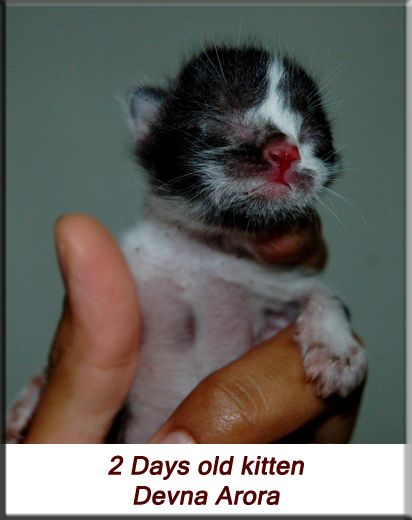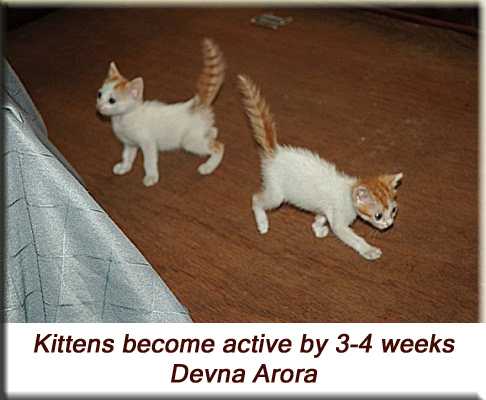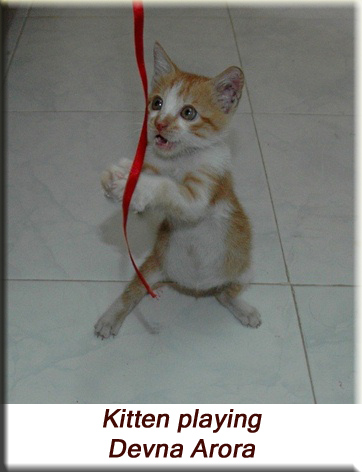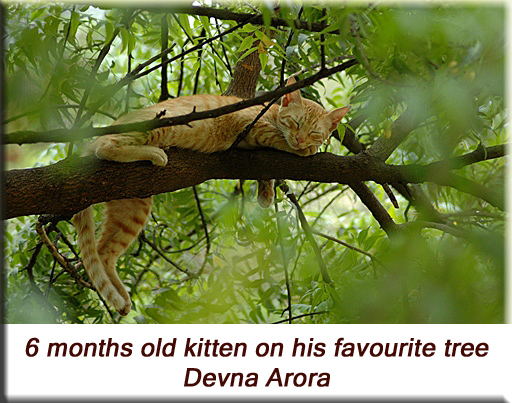Neonate care: Hand-rearing new-born kittens, contd
Devna Arora
Link to Page 1: general guidelines
Stages of growth and the corresponding care for the kittens
There is a fair variation in the size and weight of different breeds of cats with the smallest of breeds weighing as little as 2 kilos while the heavier ones may well weigh around 10 kilos. The weight difference may be even more pronounced when taking wild cats into consideration. The smaller the breed, the smaller will be the kittens. It must be noted that smaller sized kittens may require more warmth than bigger sized kittens as smaller bodies tend to lose heat a lot faster than bigger ones.
This document has been made keeping in mind an average sized kitten (of cross-breed domestic cats) that would weigh roughly 90-100 grams at birth. Bigger kittens would obviously require more feed while smaller ones would require less but the feed concentration would remain roughly the same. Fresh arrivals also tend to accept smaller quantities of feeds until they have stabilized, and have settled down and adjusted to the handling and feeding. Each individual foster may prepare the feed differently, using different formulas and dilutions – this too would affect the quantity required. It is therefore impossible to outline specific quantities and the best way to gauge your kitten’s requirements would be by monitoring it – the kitten must look healthy and satisfied. The average kitten would gain roughly 10 gms of weight each day.
A word of caution: Enthusiastic kittens may easily overfeed and beg even on a full tummy. They must not be overfed as this will immediately cause diarrhoea. Over-feeding may also make them regurgitate. The suckling reflex of most kittens isn’t easily satisfied because they get a tummy-full a lot faster through a feeding bottle or syringe than they would when suckling on the mother.
Kittens have a strong suckling reflex and will suckle on your hands and fingers even after they have been fed. Although this might seem quite endearing for most people, it is not hygienic for the kittens and they must NOT be encouraged to suckle on your hands.
New born kittens that haven’t been stimulated adequately during meal times are likely to soil the box. If the bedding has been soiled, the kittens must be cleaned immediately and their bedding changed.
Week 1 – New-born kittens
Kittens are born with a short, sparse coat of fur, their eyes and ears closed and ears folded back. They also appear quite pink – mostly visible when you look at the underside. Their sense of smell gradually develops over the first couple of days which helps them in finding their way to the mother’s teats. They also start responding to your touch within the first couple of days itself. Kittens are extremely delicate at this stage of life and need rather tender handling and care. They will sleep all through the day and only wake to feed.
New-born kittens must be fed carefully with their bodies supported when feeding them. Their suckling reflex is poorly developed and they may take 10-15 minutes per feed. New-born kittens always lie on their stomach. They must NOT be rolled onto their back as it makes them very uncomfortable and they don’t have enough strength to roll over which adds to an unnecessary struggle. Holding or forcing them into unnatural positions could also make them regurgitate and choke.
As a general rule of thumb, neonates must never be given more than 5% of their body weight in any one feed. Giving larger quantities of feed in one go easily results in diarrhoea. They must therefore be given several feeds throughout the day to achieve their daily requirements.
Feed: Kitten milk replacers (KMR) are ideal for neonate kittens. If KMR is unavailable, a home-made formula using infant formula milk and egg yolk with added vitamins and supplements must be used. Egg yolk must comprise ¼ of the formula. The feed should be prepared as per the instructions given for the feed (and the yolk added) and then diluted to a concentration of 70% formula and 30% water for the first few days of the kitten’s life. This makes the formula easier to digest and addresses any concerns of dehydration. Probiotics and digestive enzymes must be added to the formula from the first day itself.
[For more information, please refer to Feed Composition in the previous page]
Quantity per feed: The kittens will consume 3-4 ml per feed for the first few days of their life. The quantity must gradually be increased by 0.5–1 ml per feed every day or every other day. The kittens should consume roughly double the quantity of feed by the end of the first week. The kittens must be allowed to have a tummy-full if they prefer to feed more but they must never be forced un-necessarily as it only does them more harm. Kittens at this age are rarely greedy and it is best to let the kitten feed until it falls asleep. The kitten’s health and behaviour is the best guide to its nutritional requirements and fulfilment.
Feeding frequency: New-borns require 8-10 feeds per day. Each feed should be 2–2½ hours apart. They can be given a 4-6 hour gap between their feeds at night. Each feed must take at least 5-10 minutes and the flow of the feed must be adjusted accordingly. It is vital not to hasten the speed of the feed as it can easily result in aspiration in the young of this age.
Special care: The normal body temperature of a young kitten is 100-102 ˚C whereas the normal temperature of a new-born kitten would be about 97-99˚C. They are unable to thermoregulate at this age and must be kept at room temperatures of about 90˚C. A room thermometer may be used to gauge the temperature.
Simply put, new-borns require a warm (never hot) hot-water bottle throughout the day even at normal room temperatures. The hot-water bottle must be checked every time the young are fed as it will need to be refilled with warm water every 2-3 hours. Even though the new-borns need not be fed through the night, their hot-water bottle must be changed once mid-way through the night, around 2-3 am.
Week 2
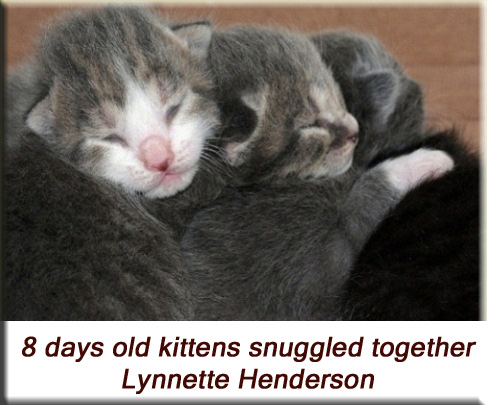
The kittens rapidly put on weight in the first few weeks of their lives, their fur becomes darker and denser and their sense of smell sharpens – they will be able to smell you out in a room especially if they can smell their feed. The kittens are stronger and begin to lift themselves in the second week. By the end of the week they will even be able to pull themselves out of the tubs and boxes of lesser height. The kittens will sleep all day unless disturbed and continue to wake up only for meals. The kittens will now suckle very well and should suck the feed from even a syringe, much as they would from a milk bottle. The use of the plunger would now be unnecessary but to slow the flow of the feed.
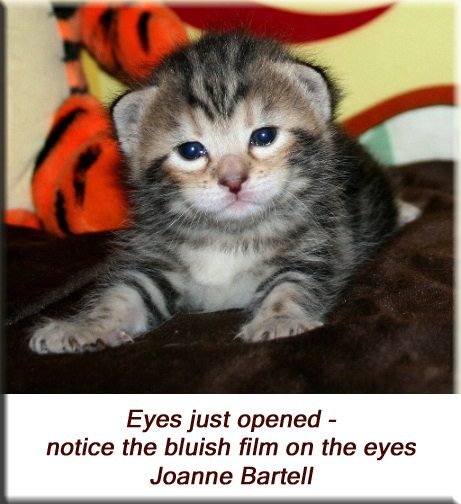
The kittens’ eyes start to open by the end of the 2nd week, typically around 10-14 days of age. Hand-reared kittens rarely open their eyes at an early age – perhaps due to nutritional inadequacies or due to the lag between being rescued and put on an appropriate diet. You will first notice a teeny slit in the eyes and the eyes open completely in another 2-3 days. There is a bluish film covering and protecting the eye for the initial few days and there is little visibility at first. This gradually fades and the kittens begin to see.
Feed: Same as the feed for week 1 but you will no longer be required to dilute the feed anymore. Minute amounts of infant cereal may also be introduced to the feed 2-3 times a day. The formula may also now be prepared in fish stock instead of plain water. A drop of Digiton (digestive drops) or gripe water can also be started once or twice a day.
Quantity per feed: The kittens would consume 6-8 ml per feed (or less if given concentrated feeds) by the beginning of the second week. The feed must gradually be increased by 1 ml per feed every day or every other day. As the frequency of the feeds reduces, the quantity of feed must be brought up to roughly 10 ml of undiluted feed per feed by the end of the second week.
Feeding frequency: The young require at least 7-8 feeds a day. Each feed should be 2½–3 hours apart and the kittens can be given a 6 hour gap at night.
Special care: The normal body temperature of a week-old kitten would be about 98-100˚C and they would require the same care as that required by new-born kittens. However, as they are adequately furred by the second week, they may require less warmth during the day. The use of the hot-water bottle may be reduced or discontinued (for example, discontinued only during the warmer afternoons of the Indian summers) depending on the weather conditions and the kittens’ requirements. Kittens kept with their siblings may also require less warmth during the day while lone youngsters are more likely to require a hot-water bottle throughout the day. In most cases, the kittens may only require the hot-water bottle in the morning, late evening but definitely at night.
Week 3 – 4
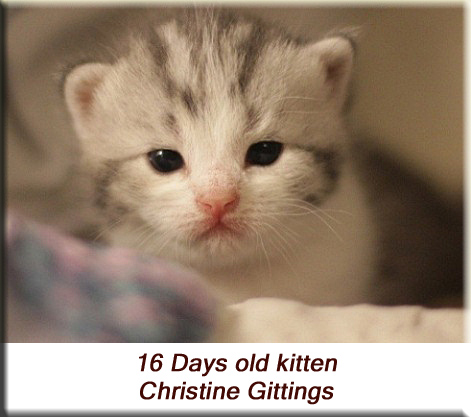
The kittens slowly start responding to visual stimuli in the 3rd week. Their ears also begin to open in the 3rd week and they slowly start responding to sounds. Their muscles develop rapidly at this stage and they are able to take their weight on the legs and even if wobbly, will attempt to walk around. The kittens also start rolling on their backs in the second week and comfortably roll over in the 3rd week. It will be safe to give them a belly rub at this stage and play with them while they are lying on the backs but you must let the kitten decide when it wants to roll over.
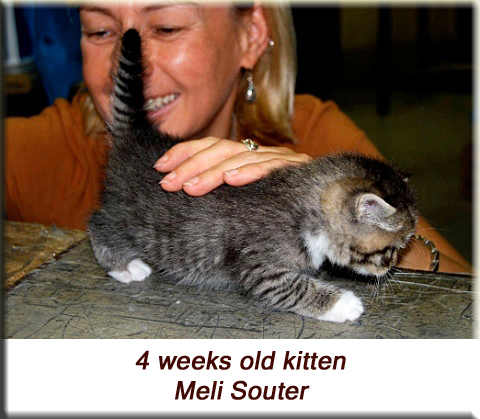
The kittens feed vigorously and may claw you in the excitement as their claws are very sharp at this stage. Some fosters prefer to wear gloves or cover your hands with cloth while feeding them to prevent scratches.
The first set of incisors erupts by the time the kitten is 3-4 weeks old. By the 4th week, the kittens will also attempt to feed out of a bowl. They must be offered small quantities in shallow bowls initially until they learn how to eat out of a bowl. Soft meats like cooked fish, chicken or turkey, and processed kitten foods, for example, Whiskas or Eukanuba Kitten – in jelly form, may now be introduced to their diet and will comprise of 20-25% of the kitten’s diet. Although most kittens are naturally attracted to the smell of the meats, they may be given formula mixed with the meat/kitten feed if they seem reluctant to feed.
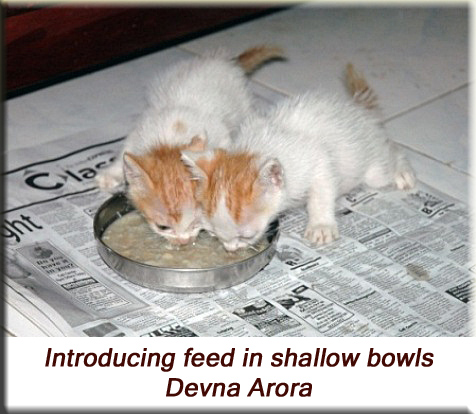
Feed: The proportion of infant cereal may gradually be increased to 10-15% per feed. The formula may also now be prepared in fish or chicken stock instead of plain water. Cooked and blended meats may also be introduced in minute quantities – not exceeding 10% in the 3rd week and 25% in the 4th week. The vitamins, probiotics and digestive enzymes must be continued. Each kitten will require about 2 pinches of probiotic powder 2-3 times a day. 1-2 drops of Digiton or gripe water can also be added to alternate feeds.
Quantity per feed: The quantity of formula consumed will gradually increase of 15 ml per feed in the 3rd week but may not increase substantially as the kitten’s reliance on meats and processed foods increases. The kittens may either be given a mix of formula and feed/meat in each feed, or they may be given alternate feeds of formula and feeds/meats depending upon your convenience and the kitten’s acceptance.
Feeding frequency: At 3 weeks of age, the kittens can be given 6 feeds a day with an 8 hour gap at night. Each feed should be 3 hours apart. At four weeks of age, the kittens may be given 5 feeds a day with 3 ½ -4 hour gaps between feeds and an 8-10 hour gap at night.
Special care: The hot-water bottle may be completely discontinued during the day and also at night unless the nights are cold. The kittens must be kept in warm spaces with adequate warm bedding nonetheless.
Kittens have a natural tendency to relieve themselves on soil/sand and will readily accept a litter-tray. The kittens will attempt to move away from the bedding and sleeping area when they want to relieve themselves. They are fairly mobile by this age and must simply be placed on the box once they are about to relieve themselves so they get the idea. The litter-tray must only be a couple of inches deep so the kittens can climb it easily at this age and it must be kept in their vicinity. The litter must be changed every 2-3 days (or more frequently if using a smaller box initially) as the kittens will avoid a soiled tray.
Water
As the kitten’s reliance on solid foods begins to increase they require additional water to maintain their hydration levels. This will be particularly important once dry kibble is introduced. Kittens will start to drink water from a bowl by 4-5 weeks of age and there must be a bowl of fresh drinking water for them at all times.
1 – 2 months
The kittens will be confidently eating out of a bowl by the time they are a month old. Their reliance on solid foods too will have increased. The kittens will now play for a longer duration after their feed and then fall asleep again. They will also now start climbing and often curl up in warm, soft and comfortable spaces like sofas, pillows, blankets, etc.
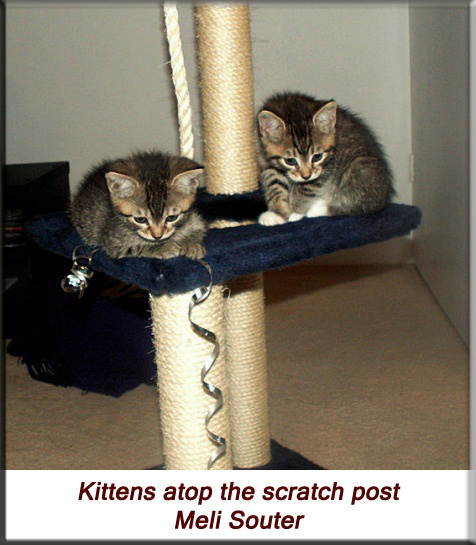
Kittens must be given plenty of space and freedom to run around and play in order to get exercise and for the muscles to develop well. Exercise is also important for co-ordination, gastro-intestinal tract functioning and learning, and the kittens must be given ample play time. Sunlight too plays an important factor in the development of the young and lack of the same can result in rickets.
Feed: Similar feed as that given in week 4 but the kittens may be offered an entire boiled egg, including the white, if they like it. Weaning begins at this stage and the quantity of formula can now be decreased. The kittens must be completely weaned by 6-8 weeks of age, with milk or formula only given as a treat to kittens that both enjoy and digest it. The kitten’s diet will primarily comprise of boiled fish, chicken or turkey with stock and other commercial kitten foods. Entire pieces of chicken and fish may be offered to the kittens as they will now carefully eat around the bones without any danger of choking. Dry kibble or dried fish and shrimp may also be introduced in small quantities to the kitten’s diet. Fresh drinking water, esp. when offering dry kibble, must be available for the kittens at all times.
Quantity per feed: 1 small sized bowl as per the kitten’s requirements and energy expenditure. It is much easier to judge the kitten’s requirements at this stage than it is when they are younger. The kitten must be fed as much as it will eat in one go and must be offered a fresh feed at the next scheduled time. Small amounts of dry kibble may be kept in a separate bowl for the kittens to snack on between their meals.
Feeding frequency: 4-5 feeds a day with an 8-10 hours gap at night.
Special care: The kittens will be inquisitive and will want to thoroughly explore their surroundings. It is extremely important to “kitten proof” the house at this stage. The kittens will want to climb onto everything and you must ensure that nothing can dislodge and fall on the kittens. You must also be particularly careful of loose wires as they will attempt to nibble on them. Keep anything dangerous like knives, scissors, glues, chemicals, cleaning liquids, etc. well out of the kitten’s reach. If the kitten can reach it, it will likely end up in its mouth at some point of time!
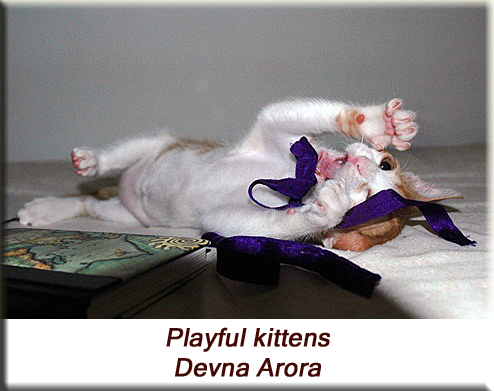
Homing kittens
The ideal time to home kittens is just when they are weaned, which is at roughly 6 weeks of age. There is no substitute for mother’s milk and the kittens must never be separated from her whilst still feeding from her. Small kittens also require a lot of attention and care which is best given to them by the mother.
Hand-reared kittens, on the contrary, can be given to good homes at any point of time as long as the new home can commit to the extensive care required by small kittens. Neonates must preferably only be homed after 3-4 weeks of age as very few people will be able to give them the required time and care.
Minimizing imprinting – relevant only for wild felids
Imprinting is a process by which a young animal learns and impersonates the behaviour patterns of the surrogate parent, human or other animal, thereby forgoing behaviour patterns essential for its survival in the wild. The young must therefore only be handled by as few people as required. This ensures that they will only look upon the handler as their foster parent and not seek security from humans in general. Refrain from housing the young with animals of different species as the young may begin to impersonate the behaviours of the other species, which might not be conducive for their survival as well.
2 months onwards
The kittens are full of energy, extremely inquisitive and naughty by this age but are mostly only active in short bursts. They must have adequate toys to entertain them. They need a lot of play time when awake but will sleep for about 18-20 hours a day on average.
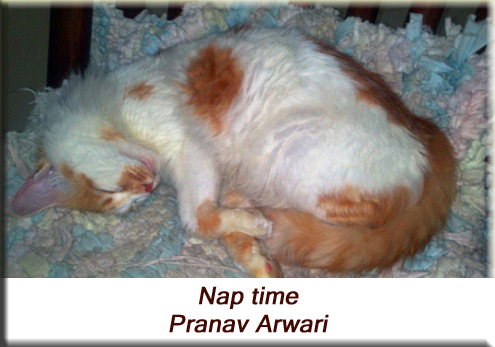
Meals per day for growing kittens:
Age - Number of meals
1-2 months – 5
2-3 months – 4
3-5 months – 3
5-8 months – 2
8 months and over – 1-2
Adequate vitamins and supplements must be given to growing kittens. Adult kittens may be given one snack and one meal every day.
Deworming schedule
The kittens need to first be dewormed when they are 4 weeks old and again when they are 6 weeks old. Growing kittens need to be dewormed periodically and it would be best to consult your veterinarian for a deworming schedule.
Vaccinations schedule
The kittens will require Feline Distemper combination (Panleukopenia, Rhinotracheitis and Calicivirus), Feline leukemia, anti-rabies vaccinations and their boosters which will begin once the kitten crosses 1 ½ to 2 months of age. FIV, FeLV and Bordetella vaccinations may also be recommended. The vaccine schedule may differ according to the country you are based in and it is best to get a current schedule from your veterinarian.
Acknowledgements
I thank Dr. Deepak Tulpule for caring for my kittens through the years and giving them the best veterinary care that they can get.
I thank my dear friends Sujitha, Suhridh, Sujaya, Shanti auntie and Varsha for always being there selflessly every time I need a hand and helping with all the adoptions. Bless you!
Christine, David, Joanne, Lynette, Meli, Pranav ‘n Rodrigo, thank you for your good wishes and the permissions to use your photographs. Kamalakannan, Saleem ‘n Varsha, thank you for being there at the right time and helping to click the photographs – they were a vital part of this document.
Photographs used
Christine Gittings – 16 Day old kitten
http://www.flickr.com/photos/gittingsc/6869703530/in/photostream/[Accessed: 29/01/2013]
David Legnon – Tucked in under a fold of cloth
http://www.flickr.com/photos/donniedark0/3130121414/in/photostream/[Accessed: 29/01/2013]
Joanne Bartell – Eyes just opened
http://www.flickr.com/photos/junglelure/3509570090/[Accessed: 29/01/2013]
Lynette Henderson – 8 Days old kittens
http://www.flickr.com/photos/lynnette_henderson/3810936809/[Accessed: 29/01/2013]
Meli Souter – 4 weeks old kitten
http://www.facebook.com/media/set/?set=a.11867796551.19551.607866551&type=3[Accessed: 04/02/2013]
Meli Souter – Kittens atop their scratch post
http://www.facebook.com/media/set/?set=a.11867796551.19551.607866551&type=3[Accessed: 04/02/2013]
Pranav Arwari – Nap time
[Emailed photograph on 29/01/2013]
Rodrigo Trovão – kitten sleeping with his stuffed toy
http://www.flickr.com/photos/rodrigotrovao/4245998404/in/
photostream/ [Accessed: 29/01/2013]
Kitten milk replacement formulas and supplements
Beaphar’s Kitty milk
http://www.vetuk.co.uk/dog-supplements-cat-supplements-early-pet-care-c-5_270/beaphar-kitty-milk-200g-p-8506
GNC Premium milk replacer for kittens
http://www.gnc.com/product/index.jsp?productId=4448051
Hartz Milk Replacer for kittens
http://www.hartz.com/Hartz_Products/Cat_Products/Health_and
_Wellness/Milk_Replacers.aspx
MillPledge Veterinary’s KittyStim
http://www.millpledge.com/Products_Range/Nutraceuticals_Pharmaceuti
cals/Colostrum_Probiotic_Absorptive/Nutraceuticals_KITTYSTIM.html
Pet Ag’s Kitten milk replacers
http://www.petag.com/product/cat-milk-replacers/kmr-powder-2/
Pet Ag’s Taurine tablets
http://www.petag.com/product/cat-nutrition-supplements/taurine-tablets/
References
Arora, D. (2013) Neonate care – hand-rearing new-born puppies, Rehabber’s Den. [Online] Available from:
http://rehabbersden.org/Neonate%20care%20-%20Hand-rearing%20new-born%20puppies.pdf[Accessed: 25/12/12]
Bosworth, A.W. and Van Slyke, L.L. (1916) A comparison of the composition of cow’s milk, goat’s milk and human milk. [Online] Available from:
http://www.jbc.org/content/24/3/187.full.pdf[Accessed: 30/01/13]
Hedberg, G. (2002) Exotic felids In: Gage, L. J. (2002) Hand-rearing wild and domestic mammals, Iowa State University Press, Blackwell Publishing Professional
Hines, R. (no date) Bottle feeding orphaned kittens [Online] Available from:
http://www.2ndchance.info/orphankitten.htm[Accessed: 23/01/13]
Roach, P. (1995). The Complete Book of Pet Care. Revised and Updated. Australia: Lansdowne Publishing Pty. Ltd.
Summers, L. (2002) Domestic kittens In: Gage, L. J. (2002) Hand-rearing wild and domestic mammals, Iowa State University Press, Blackwell Publishing Professional
Trendler, K. (2005). The Principles of Care and Rehabilitation of Orphaned Wild Mammals. In: Menon, V., Ashraf, N.V.K., Panda, P., and Mainkar, K. 2005. Back to the Wild. Studies in Wildlife Rehabilitation. Conservation Reference Serious No.2. Delhi: Wildlife Trust of India. pp. 46-53.
Further reading
American Bird Conservancy (2013) Cats, Birds and You [Online]. Available from:https://www.abcbirds.org/abcprograms/policy/cats/materials/cat_
brochure.pdf [Accessed: 06/02/13]
Andrews, P. (no date) Hand-rearing of small felids [Online]
Available from:
http://www.gailhedberg.com/storage/Hand-Rearing%20Small%20Felids%20Penny%20Andrews%20Hexagon%20
Farms.pdf [Accessed: 25/01/13]
Blahd, Jr., W.H. and O’Connor H.M. (2010) Rehydration drinks [Online]
Available from: http://www.webmd.com/hw-popup/rehydration-drinks?navbar=hw86827 [Accessed: 27/01/13]
Blue Cross UK – Looking after your cat [Online] Available from:
http://www.bluecross.org.uk/1957/looking-after-your-cat.html [Accessed: 23/01/13]
Breed, M.D. (2010). Both Environment and Genetic Makeup Influence Behavior. [Online] Available from:
http://www.nature.com/scitable/knowledge/library/both-environment-andgenetic-makeup-influence-behavior-13907840 [Accessed: 18/10/10]
Dugdale, D.C. (2012) Lactose intolerance. [Online] Available from:
http://www.nlm.nih.gov/medlineplus/ency/article/000276.htm[Accessed: 31/01/13]
HDW Enterprises and Foothill Felines Bengals and Savannahs (no date) Kitten/Cat care basics: Glop recipes [Online] Available from:
http://www.hdw-inc.com/glop.htm [Accessed: 23/01/13]
Eukanuba (no date) Taurine and its importance in cat foods [Online] Available from:
http://www.eukanuba.com/en-US/cat-guide/Taurine-and-Its-Importance-in-Cat-Foods.jspx [Accessed: 01/02/13]
Kittens Lair (2008) Cat water requirement [Online]
Available from: http://www.kittens-lair.net/cat-food-and-nutrition/cat-water-requirement.html [Accessed: 01/02/13]
Levy, J.K. (2001) Use of adult cat serum to correct failure of passive transfer in kittens [Online] Available form:
http://www.unboundmedicine.com/evidence/ub/citation/11724178/Use_
of_adult_cat_serum_to_correct_failure_of_passive_transfer_in_kittens_[Accessed: 25/01/13]
Milk facts (no date) Milk Composition. [Online] Available from:
http://www.milkfacts.info/Milk%20Composition/Milk%20Composition%
20Page.htm [Accessed: 30/01/13]
Rainbow Wildlife Rescue (no date) How to raise an orphaned kitten [Online] Available from:
http://www.kittenbaby.com/ [Accessed: 23/01/13]
The Hartz Mountain Corporation (no date) Hartz Nursery – Kittens [Online] Available from:
http://www.hartz.com/Cats/Hartz_Nursery/Kitten_Articles.aspx[Accessed: 23/01/13]
Wikipedia (no date) Cat [Online] Available from:
http://en.wikipedia.org/wiki/Cat [Accessed: 27/01/13]
Please note: This document is targeted at hand-rearing alone and does not address or substitute any veterinary procedures. For any medical concerns, please consult your veterinarian at the earliest.
For amateurs or people handling a new born kitten for the very first time, please keep in touch with a trained and experienced hand for guidance and regular progress updates.
Protocol published in 2013

